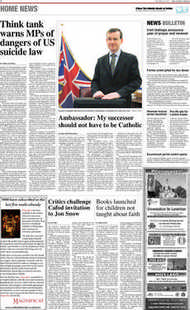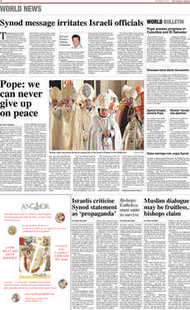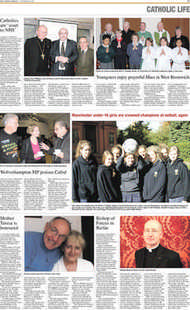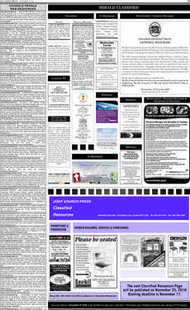Page 8, 29th October 2010
Page 8

Report an error
Noticed an error on this page?If you've noticed an error in this article please click here to report it.
Tags
Share
Related articles
Knotty Ques Tions Parts Of Vatican Ii Are Hard To...
Christendom Awake By Aidan Nichols Op, T&t
An Unhealthy Feel
A 'liturgical Stammer'?
Catholics Remain Confused About The Liturgy
Did Vatican II usher in our secular age?
Author Moyra Doorly and theologian Fr Aidan Nichols conclude their correspondence about the state of the Catholic Church today
Dear Fr Aidan,
Perhaps I could begin this letter on religious liberty, the last in the series, by challenging the basis of your argument, which seems to be that the inadequate doctrinal formulations contained in the documents of Vatican II must be tolerated as long as sound doctrine is also found.
In previous letters you acknowledged that the Council documents contain “failures of prudence” and “weaknesses or unilateralism in the formulation of conciliar teaching”. Your last letter also stated that, while some aspects of Vatican II may be questioned, a similar liberty does not exist regarding the Council’s doctrinal statements “even if we find these to be in some regard ambiguous in character”.
But would this argument stand up in a court of law, where witnesses are required to give “the truth, the whole truth and nothing but the truth”? Would Sacrosanctum Concilium convince a jury, since, as you also acknowledge, this important Council document does not even explicitly state a fundamental, traditional teaching on the sacrificial character of the Mass?
The ambiguous nature of many Council statements has long been criticised by the SSPX. Obviously, ambiguity allows for more than one interpretation, as does the presence of new theology alongside traditional teaching. This raises the question: if the liberal reformers have embraced the new theology contained in the Council documents and put it into practice, are they really to blame if the results, as witnessed by the banality of the contemporary liturgy, are so dire? Surely the aesthetic expression of the traditional liturgy was shaped by the theology of the Holy Sacrifice of the Mass, just as the conciliar liturgy is shaped by the new theology of the Eucharistic celebration at which the priest presides.
According to the SSPX, Vatican II’s new theology is contrary to the tradition of the Church and constitutes a rupture with that tradition. Traditional teaching may be present in the 1965 Declaration on Religious Liberty (Dignitatis Humanae), as it affirms “the traditional Catholic teaching on the moral duty of individuals and societies towards the true religion and the one Church of Christ” (para 1). But how can individuals and societies exercise this moral duty if they are also asked, by new teaching contained in the same document, to abandon it?
Traditional Catholic social teaching proposes the union of temporal and spiritual powers in a Catholic state, as well as the obligation of such a state to regulate and moderate the public expression of other forms of worship in order to defend its citizens against the diffusion of false doctrines which, in the judgment of the Church, endanger their eternal salvation. Going way beyond the pre-conciliar principle of religious tolerance which in a Catholic state the Church has deemed necessary for the preservation of peace, Dignitatis Humanae declares: “The right to religious freedom is based on the very dignity of the human person... [and] must be given such recognition in the constitutional order of society as will make it a civil right” (para 2).
In tune with the egalitarian spirit of the modern age, Dignitatis Humanae grants equal rights to all belief systems by asserting the obligation of the state to ensure that all religious communities are free to “honour the supreme Godhead with public worship, help their members to practice their religion ... [and] not be prevented from freely demonstrating the special value of their teaching” (para 4). Religious liberty therefore applies to all religions as the dignity of man requires and the Church now only claims her share of it. But how can a state obliged to recognise religious liberty for all religions also exercise its “moral duty towards the true religion and the one Church of Christ”? Surely, by granting equal rights to belief systems which cannot be true, since only Catholicism is true according to tradition as Dignitatis umanae affirms, religious Liberty grants rights to error and promotes the religious indifferentism of the state.
Vatican II’s teaching on human dignity is at the root of this problem, the SSPX claims, because it plays down the distinction between the dignity man possesses by virtue of his nature, and that which depends upon his actions and which can be lost by adherence to error. Man’s superior dignity in relation to other creatures, which belongs to him because God created him in His image and likeness, lost its sublime character through Original Sin which stripped man of this likeness. Thus it is by sanctifying grace that man is supernaturally able to know and love God and to enjoy the Beatific Vision.
Vatican II, however, adopted the secular liberal view which disengages human dignity from Truth, renders it independent of the obligation to turn the will towards the Good, and holds that by exercising his autonomy, which in essence means autonomy from God, modern man has achieved the highest form of liberty. Accord ingly, the culture of the “rights of man” rejects the dogma of Original Sin and man’s need of sanctifying grace, and views man as intrinsically perfect and self-sufficient.
In Religious Liberty Questioned, Archbishop Lefebvre doubts if the new conciliar teaching can be reconciled with that of Pope Leo XIII’s encyclical Immortale Dei, which states: “If the mind asserts to false opinions, and the will chooses and follows after what is wrong, neither can attain its native fullness, but both must fall from their native dignity into an abyss of corruption. Whatever, therefore is opposed to virtue and truth, may not rightly be brought before the eyes of man, much less sanctioned by the favour and protection of the law.” Not surprisingly, this teaching is at odds with the prevalent mind set of our times, as is the very notion of a Catholic state. And yet it wasn’t always so. One of the least recognised tragedies to follow in the wake of Vatican II and its new teachings has been the end of the Catholic states, which gave constitutional recognition and legal protection to the Catholic Church while accepting the private practice of other religions. For example, the 1886 Constitution of Colombia declared Catholicism to be the state religion and granted to the Church a primary role in its affairs at all levels.
Then in 1973, encouraged by the Vatican to conform with Dignitatis Humanae, Colombia amended its constitution to state merely that Catholicism is the religion of the great majority of Colombians, while the Church in that country surrendered her right to censor public university texts and ensure the use of the Catechism in schools. What’s more, the mission territories ceased to be enclaves where missionaries had greater jurisdiction than the government over schools, health and other services, which were eventually brought under government control.
This astonishing development, in which the Church voluntarily surrendered her privileged status – a status appropriate to the “true religion and the one Church of Christ”, the SSPX argues – was repeated in Spain, Italy and Argentina. In the years immediately following Vatican II, Catholic states across the world amended their constitutions in order to conform with the Council’s teaching on religious liberty, which absolves the state from its obligation towards the Church and her Divine founder, an obligation which exists because the Reign of Christ the King does not stop at the doors of parliaments and legislatures, whether they deny His Kingship or not.
According to Archbishop Lefebvre in A Bishop Speaks: “They thought that they would attract the world by accepting the ideas of modern man... who is a liberal, who is a modernist, who is a man who accepts the plurality of religions, who no longer accepts the social kingship of our Lord Jesus Christ. This I have heard twice from the envoys of the Holy See, who told me that the social kingship of our Lord Jesus Christ was no longer possible in our time; that we must accept definitely the pluralism of religions. That is what they told me; that the encyclical Quas Primas which is so beautiful, on the social kingship of our Lord Jesus Christ, which was written by Pope Pius XI, would never be written today. That is what they said to me – the official envoys of the Holy See.” As someone who used to be both in the world and of the world, I have long been astonished at the rosy view of contemporary culture and ideas held by so many men of the Church. In my experience, the modern world hates the Church – it really does – even behind the smiles directed at the overtures of liberal, “open-minded” Catholics. Because the modern world wants the Church to succumb to its values, to dissolve into it and to disappear, as the last vestiges of Christendom are dismantled and the postChristian age is gleefully ushered in.
“A complete overthrow of the entire tradition and teaching of the Church has been brought about since the Council by the Council,” Archbishop Lefebvre maintains. It is difficult, then, to argue that this does not apply to Vatican II’s Declaration on Religious Liberty. And it is equally difficult to see how a Church which carries the legacy of a stripped down, emptied out faith can withstand a world which desires only its end.
Best wishes, Moyra Dear Moyra,
Thank you for this powerfully worded letter on the Second Vatican Council and the responsibility of the state authority to the true religion. This will be our last exchange in the pages of The Catholic Herald so I must begin, as you yourself do, by reminding readers of the ground rules of our debate, as I see it.
First, you rightly report that I do not see any theological difficulty about querying the wisdom of some of the reform provisions made by the Council. Matters that turn on the exercise of practical wisdom in particular sets of circumstances do not involve the “charism of truth” given to the total episcopate, under and with the Pope, by virtue of the high priesthood which, by ordination, is theirs. The equivalent of such “practical provisions” in earlier Ecumenical Councils chiefly takes the form of canons, many of which are now, rightly, set aside. For example, the First Lateran Council forbade monks from celebrating Mass in public churches and from hearing confessions; the Fourth Lateran Council insisted on Jews wearing distinctive dress; the Second Council of Lyons required papal conclaves to be held in whatever city a pope happened to die. (And I cannot forbear from mentioning that the Council of Vienne penalised abbots and priors who wore unlaced boots or rode horses with decorated saddles!) Secondly, I have conceded that the doctrinal statements of a Council (which, obviously, are far more important for the Church of all ages) may be less than balanced or comprehensive in character and thus, by implication, need supplementation, whether from another Council or from other sources. The development of Christological doctrine in the early centuries, from Ephesus to the Third Council of Constantinople, substantiates, I believe, this view. Were the Church to have drawn a line under that develop ment at any point before the last of the four Councils concerned, we should not have had the beautifully equilibrium of our doctrine of the Word incarnate, a pre-existing divine Person now energising in his two natures, with his twofold divine and human will.
And then thirdly, you note that, for me, a conciliar formulation of Catholic truth may be, in some respect, ambiguous in character. One obvious example at the Second Vatican Council is the teaching on the inerrancy of Scripture in the Dogmatic Constitution on Revelation which (according, at least, to many interpreters) leaves open two possibilities: that all Scripture is materially inerrant, and that all Scripture is inerrant in the formal perspective of its bearing on human salvation. You ask whether a Council that has produced such ambiguities can still be credited. I reply that, if it cannot, then no more can earlier Councils the texts of which, at certain points, exhibit grey areas to which the subsequent Magisterium, assisted by the theological schools, must attend. Thus, for instance, it is disputed whether the Council of Trent taught that revealed truth is to be found partly in Scripture and partly in Tradition, or, alternatively, that revelation is transmitted wholly in both.
We must not ask for perfection from Councils, even in their strictly doctrinal aspect. It is enough to know that, read according to a hermeneutic of continuity, they will not lead us astray. An Ecumenical Council will never formally commit the Church to doctrinal error. It is, moreover, unfair to ask of Councils what they have not claimed to provide: to demand, for instance, from the Second Vatican Council a doctrinal overview of the Mass considered as Eucharistic Sacrifice, something the fathers of that Council never attempted. I think the “court of law” to which you appeal would vindicate me on that point, at any rate if equity were among its principles.
Will this, then, be my defence of Vatican II on the neuralgic issue to which we are devoting the bulk of this last exchange of letters, the Declaration on Religious Freedom? In theory it could be, since, while acknowledging the duty of civil society to recognise the Gospel of God, the Council takes it as read and proceeds to put forward a further teaching – on the right of persons not to be coerced by the state in their religious convictions – which is relevant to that acknowledgement but also distinct from it. The Council did not set itself the task of expounding what it called “the traditional Catholic teaching”. Where liberal Catholics have gone astray is in their supposition that the innovatory teaching on the right to religious freedom contradicts the earlier teaching of the Church on the rights of revelation in a Catholic state (thus briefly acknowledged). That has proved an extremely damaging mistake. Not only has it led mainstream Catholics, even when historically and currently the majority in certain societies, more or less to privatise their faith, dismantling the canopy it provides for life together as a whole. It has also become a precedent – or, rather, a pseudo-precedent – for appeals for the deconstruction of other stably possessed doctrines of the Church, notably in family ethics, but by no means exclusively there (the topic of the ordination of women comes to mind).
In the words you quote from its opening paragraph (and I have to congratulate you, Moyra, on noticing them, which is more than some people have done), the bishops at Vatican II assert that they propose to leave conceptually untouched the traditional doctrine about a Christian society. What they do instead, in the course of the document, is further to develop the long-standing theology of Christian initiation for which the act of faith may never be forced on anyone, in any circumstances whatsoever. Metaphysically considered, that respect for conscientious lack of conviction turns on the dignity of the human hypostasis (the basic human self), for, pace Mgr Lefebvre, the dignity of persons remains intact after the Fall, in line with the doctrine of the Council of Trent that the imagehood of God in man is damaged by Original Sin, but not destroyed by it. That is the real basis of the “new” doctrine which, consequently, can claim the status of a homogeneous, not heterogeneous, doctrinal development.
But unlike (I would say), the Eucharistic doctrine of the Constitution on the Liturgy, the Declaration on Religious Freedom occasions a genuine difficulty for orthodox Catholics. As you point out, it is not immediately apparent how to reconcile its acknowledgement of the traditional teaching about the Christendom state with its development of the teaching about the freedom of the act of faith. If we are unpersuaded of a difficulty here, we have only to look at its aftermath. Except among two groups, the period since the Second Vatican Council has witnessed a withdrawal from “theo-politics” on the part of the hierarchy. Traditionalists and Liberation theologians, neither group popular with Rome, are the two constituencies that have most vocally supported a continuing appeal to civil society to recognise evangelical and Catholic truth not just in the private lives of individual citizens but also in its public institutions, which include its own legal form, the state. Does the Declaration bear some responsibility for this dereliction of duty? I do not think we can wholly exculpate the Fathers of the Council who were aware of the difficulty involved yet chose (through, I take it, a desire not to prolong further a contentious debate) to restrict to a passing mention their acknowledgement of what I prefer to call, more in the idiom of Chesterton and Christopher Dawson than Lefevbrists or Liberationists, the thesis of “Christendom”.
It is true that the state establishment of the Church has produced, historically speaking, many inconveniences. When, during the Third French Republic, anti-clerical politicians rejected the Liberal thesis of a “free Church in a free state” in favour of continuing establishment, they did so because, in the words of one of their number, the maxim could only mean “an anarchic Church in an impotent state”. A state church may well enable infidel statesmen to control the Church, as when 10 freethinkers on the Conseil d’Etat sat around a green carpet choosing bishops. Believing and even devout Catholic politicians and princes have, in the past, demanded their pound of flesh, as the examples of Gallicanism in France and Josephinism in Austria indicate. The secularisation of Catholic states has not been without its advantages for the Petrine office-holder.
Nevertheless, I strongly agree with you that publicly recognising divine revelation is an entailment of the Kingship of Christ on which, despite its difficulties in a post-Enlightenment society, we must not renege. Where the ethos of society is such that an elected legislature may be trusted to regard the Judaeo-Christian tradition as normative, the Church should be accorded her rightful place as “mother and mistress”. (The Edwardian priestnovelist Robert Hugh Benson’s The Dawn of All will give you the idea.) Where that is not possible there should at least be, in the former Christendom, a recognition of the historic role of the faith in forming the human patrimony and thus what a bishop of the Church of England, arguing against disestablishment, has recently termed a “symbolic privileged position”.
The reason, of course, is not to give ecclesiastics airs and graces. As you, Moyra, with your streetwise sense of realities, recognise, the point is to permeate society and culture to the highest degree possible with the Christian spirit, and to maximise the number of occasions in civic life where testimony to him and his Church might be given. Can this be compatible with acknowledging – under some more generous rubric than tolerance with a view to public order – a place under the sacred canopy of a Christendom society for followers of other religions and none? Our last round of letters throws some light on this. Meanwhile, I hope that the dialogue between the Holy See and the Society of St Pius X will come up with a truly excellent statement on this whole topic – not only for the sake of reconciliation with a minority but to renew the Christendom aspiration of the whole Church. Dear Moyra, if I may say so without offence, you may have been among the particles of grit to produce the pearl in the oyster.
Yours sincerely, Fr Aidan OP An expanded version of the correspondence between Moyra Doorly and Fr Aidan Nichols, with a foreword by Cardinal George Pell, will be published in March by Gracewing under the title The Council in Question: A Dialogue with Catholic Traditionalism
blog comments powered by Disqus





















